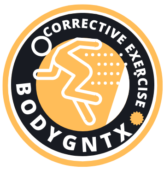Unlocking Peak Performance: A Trainer’s and Coach’s Complete Guide to Running Biomechanics: Written by Dr Neeraj Mehta (PhD. in Human Biomechanics and Alternative Medicine, a sports person with over 30 years of experience
Introduction:
Imagine your athletes gliding across the finish line, each stride a masterpiece of grace and power. Reaching this level of performance requires more than just hard work; it demands an in-depth understanding of the intricate dance between muscles and motion – running biomechanics. This guide serves as your backstage pass, unlocking the secrets of biomechanics to empower your athletes and propel them to peak performance.
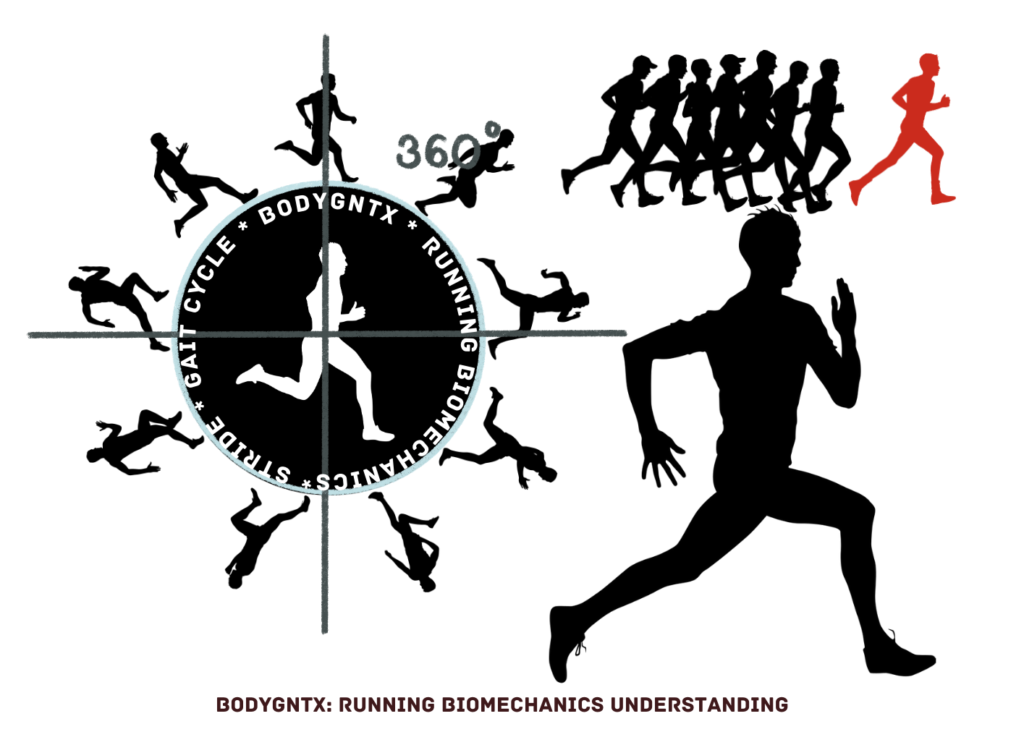
Mastering the Rhythm of Running:
The running play unfolds in two acts: the stance phase and the swing phase. Each footfall carries its own melody. Heel-stomps pound like heavy drums, while tiptoeing ballerinas strain their calves with a high-pitched note. The ideal rhythm? A graceful midfoot strike, allowing ankles to absorb shock and knees to extend for a powerful push-off.
Swing into Action: The Aerial Waltz
As one leg completes its arc, the other embarks on an aerial waltz. Hamstrings and hip flexors contract, propelling the leg forward in preparation for the next downbeat. Remember, tight hip flexors can lead to overstriding, disrupting the rhythm like a missed beat.
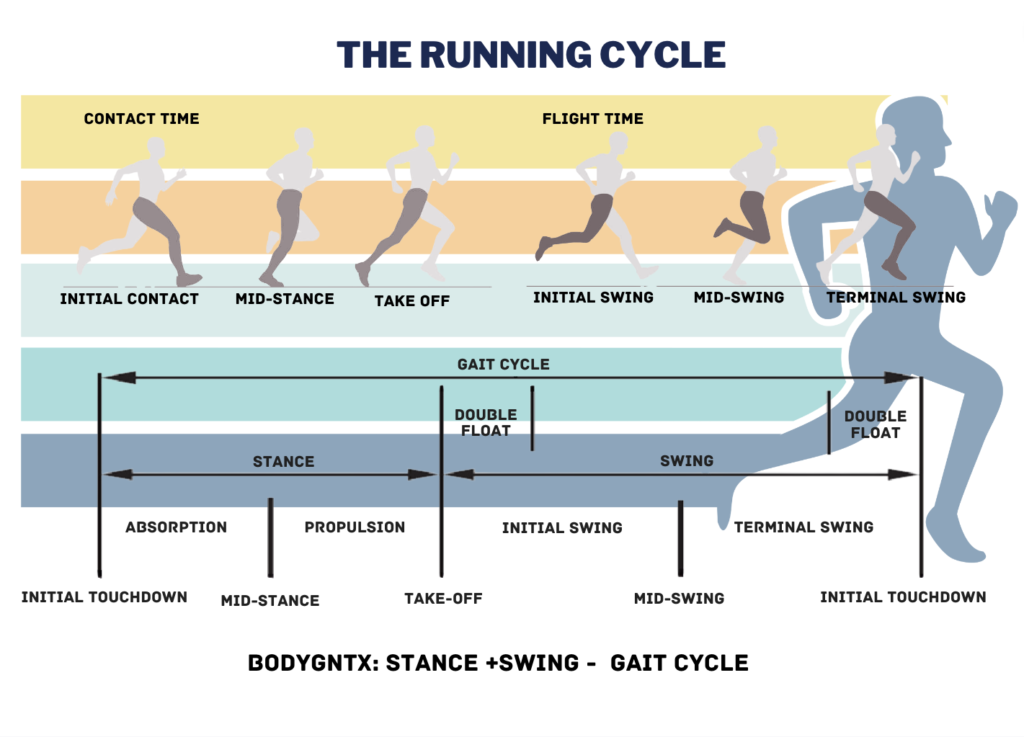
Before diving deep into running biomechanics, here are five concise pointers that encapsulate running biomechanics:
- Proper Posture:
- Maintain an upright stance with your head up and shoulders relaxed.
- Keep your chest open and engage your core muscles for stability and balance.
- Avoid leaning too far forward or backward while running.
- Foot Strike and Stride Length:
- Land softly on the midfoot or forefoot to reduce impact and prevent injury.
- Aim for a natural and comfortable stride length, avoiding overstriding or taking excessively short steps.
- Arm Movement:
- Maintain relaxed and bent arms, swinging them forward and backward, not across your body.
- Ensure your arm swing is in sync with your leg movement to optimize efficiency and balance.
- Cadence (Step Rate):
- Aim for a moderately high cadence of around 170-180 steps per minute.
- Focus on quick, light foot placement and shorter ground contact time to enhance speed and reduce stress on joints.
- Hip and Core Engagement:
- Engage your hip and core muscles for stability and power generation.
- Strive for a neutral pelvic position and avoid excessive tilting or rotation of the hips.
A Symphony of Joints: The Mechanics of Motion
Each joint plays a vital role in this biomechanical symphony:
- Ankles: Shock absorbers and propulsion engines, their plantarflexion supports every stride. Too much dorsiflexion can lead to shin splints, while insufficient motion steals momentum.
- Knees: Driving forces of the stance phase, their extension propels us forward. Hyperextension throws caution to the wind, raising injury risks, while inadequate extension leaves us limping off-stage.
- Hips: Initiators of the swing phase, their flexion sets the leg in motion. Tightness here leads to limited mobility and overstriding, a disharmonious rhythm indeed.
- Spine: The conductor of the body’s forces, it thrives in a neutral position with a slight anterior tilt. Crouching or over-tilting throws the orchestra off-key, potentially leading to back pain.
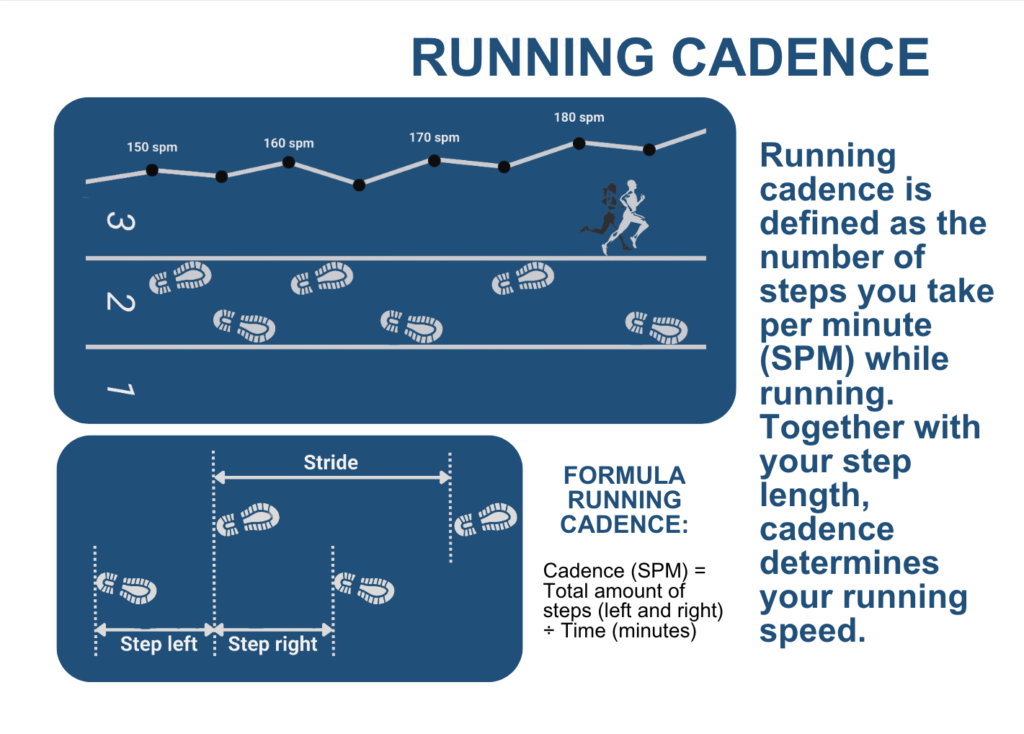
Mastering the Art of Form: Key Elements for Efficient Running
While biomechanics focuses on the intricate interplay of muscles and joints, achieving peak performance also requires attention to your athletes’ overall running form. By mastering these key elements, your athletes can unlock a smooth, efficient stride that minimizes injury risk and boosts speed:
Balanced Forward Posture:
- Stand tall with your gaze ahead, not down. Imagine a string gently pulling you upwards from the crown of your head.
- Keep your chest lifted and shoulders back and relaxed. Avoid hunching or slouching, which restricts breathing and hampers efficient movement.
- Maintain a neutral spine with a slight anterior tilt. Avoid over-arching your back or leaning too far forward, both of which can strain muscles and cause back pain.
Compact Arms:

- Focus on short, controlled arm movements that swing close to your body. Imagine your arms pumping back and forth like pistons, not out to the sides like pendulums.
- Keep your elbows bent at a 90-degree angle. Avoid letting them extend too far in front of your body, especially during casual runs. This can lead to energy waste and poor shoulder alignment.
- Relax your hands and keep your fingers slightly cupped. Clenching your fists creates unnecessary tension and restricts blood flow.
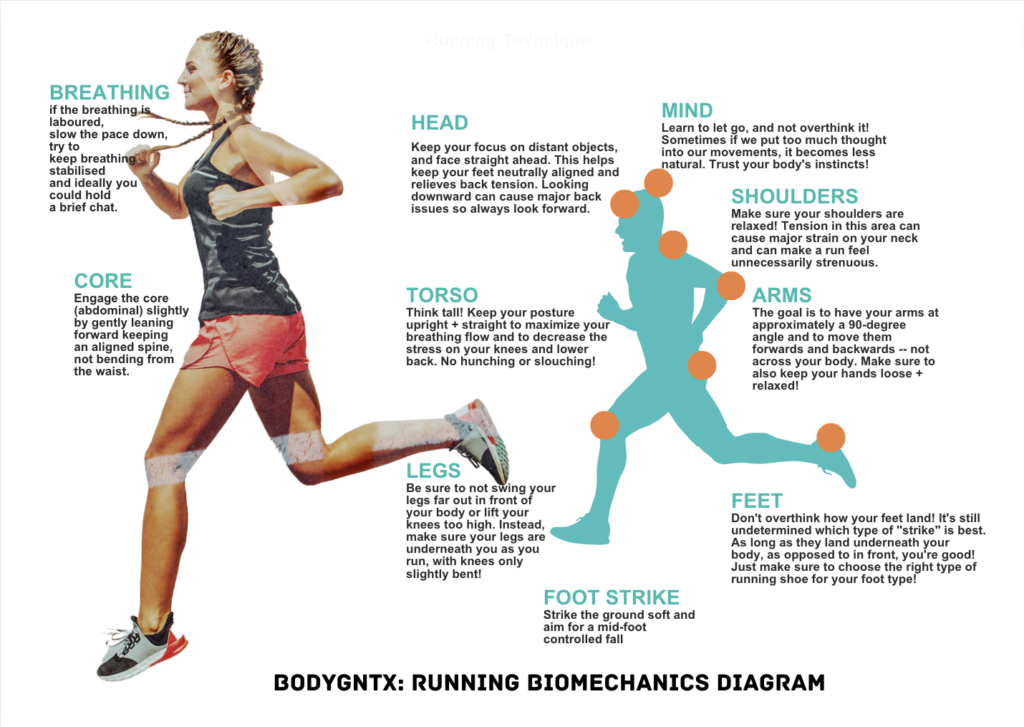
Proper Footstrike:
- Land softly with your foot beneath a slightly bent knee. Avoid heel striking, which can send shockwaves up your leg and increase injury risk. Aim for a midfoot or forefoot strike for a more efficient transition.
- Focus on a light and quick footfall. Avoid overstriding, where your foot lands too far in front of your body, creating braking forces and disrupting your rhythm.
- Maintain a high cadence of approximately 170-180 steps per minute. A faster cadence encourages shorter strides and reduces ground contact time, minimizing impact on your joints.

By emphasizing these key elements of form, you can help your athletes move with grace and efficiency, unlocking their full potential on the track or trail. Remember, good form is a journey, not a destination. Encourage your athletes to practice and refine these elements over time, seeking feedback and adjusting as needed. With dedication and focus, they can master the art of running and achieve peak performance with every stride.
Unveiling the Hidden Scorecard: Motion Analysis with Technology
Force plates and motion analysis technologies step out of the shadows, offering invaluable insights into running biomechanics. By analyzing ground reaction forces, joint angles, and movement patterns, these high-tech tools become your secret scoreboard, revealing areas for improvement and allowing you to personalize training plans for each athlete.
Fine-Tuning the Movement: Targeted Drills and Exercises
Perfecting Your Footfall:
Want to change your athletes’ striking pattern? Here are exercises to strengthen muscles that propel them forward with a midfoot or forefoot strike:
- Jumping calves: Build ankle stability and power with plantarflexion’s solo act. (https://www.youtube.com/watch?v=nqKHWh7An9c)
- One-legged calf raises: Add balance and coordination to the mix. (https://www.youtube.com/shorts/Bfl5du8ehao)
- Plyo leg lifts: Explosive training for a dynamic push-off. (https://www.youtube.com/shorts/iCuglFclkUM)
- Toe-tapped single-leg squats: A new dimension of dorsiflexion and coordination. (https://www.youtube.com/watch?v=eXtdmabnI6o)
- Barefoot running: Encourage a natural midfoot or forefoot strike on forgiving terrain. (https://www.youtube.com/shorts/fp4o1_2CjpA)
Conquering Overstriding:
Reduce overstriding with drills that increase cadence (steps per minute) while shortening stride length:
- High knees: Quick steps with knees lifted towards the chest, promoting a light and fast footfall.
- Butt kicks: Jog with heels brushing your glutes, maintaining a neutral spine and loose upper body.
- Short-stride drills: Imagine running on a ladder with narrow rungs, taking small, quick steps while keeping your back straight and core engaged.
- Walking-to-running transitions: Integrate short bursts of running into walks, focusing on high cadence and small strides.

Addressing Muscle Imbalance:
Muscle imbalances disrupt even the most well-orchestrated movement. Here are exercises to target common imbalances:
- Glute bridges and single-leg hip thrusts: For weak glutes that cause overstriding.
- Lying and standing hamstring curls: To loosen tight hamstrings that limit knee extension.
- Kneeling and lunging hip flexor stretches: For increased range of motion and reduced strain on the kneecap.
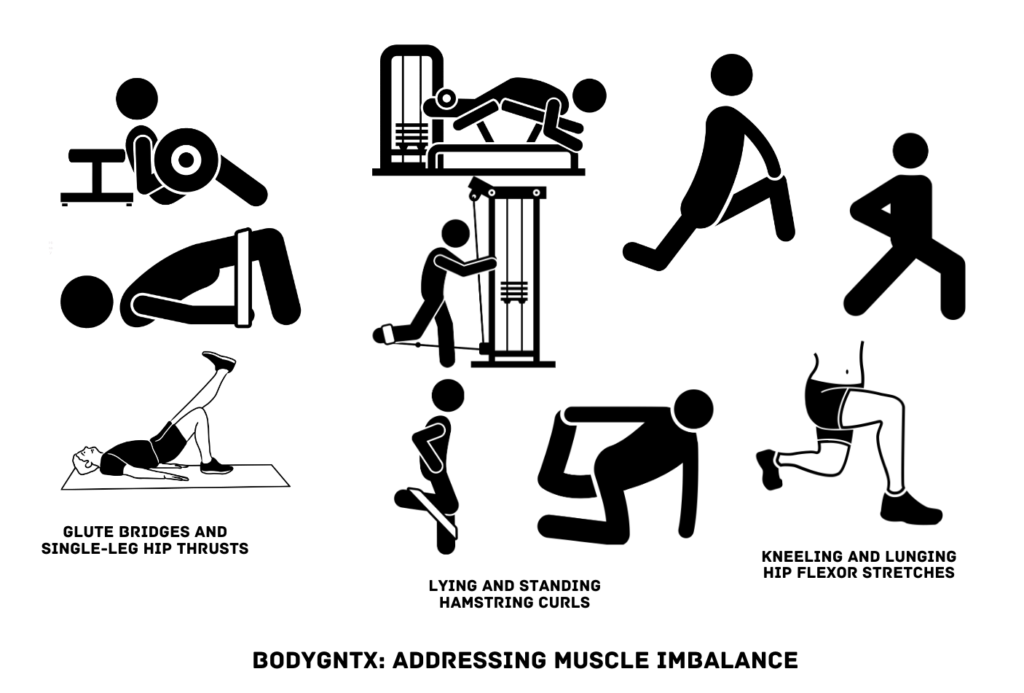
When the Music Falters: Preventing and Treating Common Running Injuries
Even the most talented performers encounter setbacks. This section equips you to diagnose and address common running injuries, helping your athletes get back on stage and perform at their best.
The Persistent Thump: Shin Splints
Microtears in the muscles and tendons surrounding the tibia can lead to this excruciating pain. Contributing factors include:
- Excessive dorsiflexion from overpronation or weak tibialis anterior muscles.
- Inadequate calf strength, leaving the tibia unsupported.
Healing Melody:
- Toe raises and tibialis anterior raises strengthen the stabilizing muscle.
- Regular calf stretches improve flexibility and reduce stiffness.
- Supportive shoes with arch support and cushioning absorb impact.
- Gradual return to running allows the body to adjust and recover.
- Cross-training activities like swimming and cycling offer low-impact alternatives.

The Misaligned Kneecap: Runner’s Knee
Discomfort around the kneecap often arises from the kneecap not tracking smoothly in its groove on the femur. Common culprits include:
- Weak quadriceps causing improper kneecap tracking.
- Tight hamstrings pulling the kneecap out of alignment.
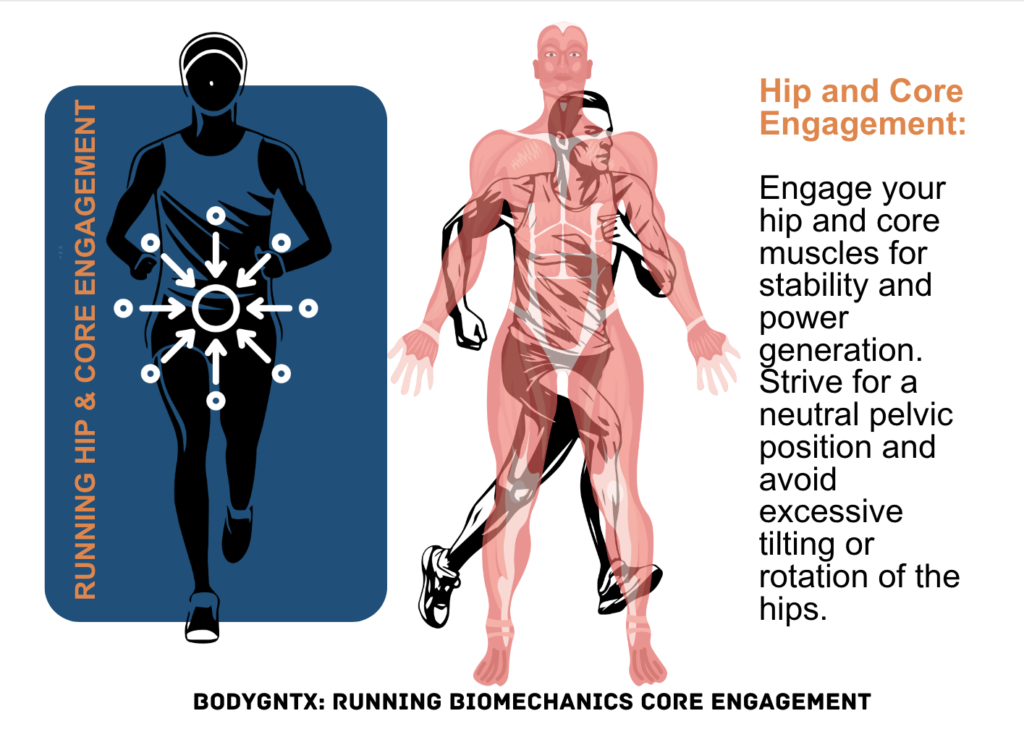
Restoring the Rhythm:
- Isometric exercises like wall sits and straight-leg raises strengthen weak quads without knee strain.
- Regular hamstring stretches increase range of motion and reduce kneecap strain.
- Patellar taping can temporarily improve tracking and offer support.
- Hip strengthening exercises like side leg lifts and glute bridges add stability and decrease knee strain.
- Ice and anti-inflammatory medication can reduce pain and inflammation.
- Modify activities to avoid pain-inducing movements like stair climbing or downhill running.
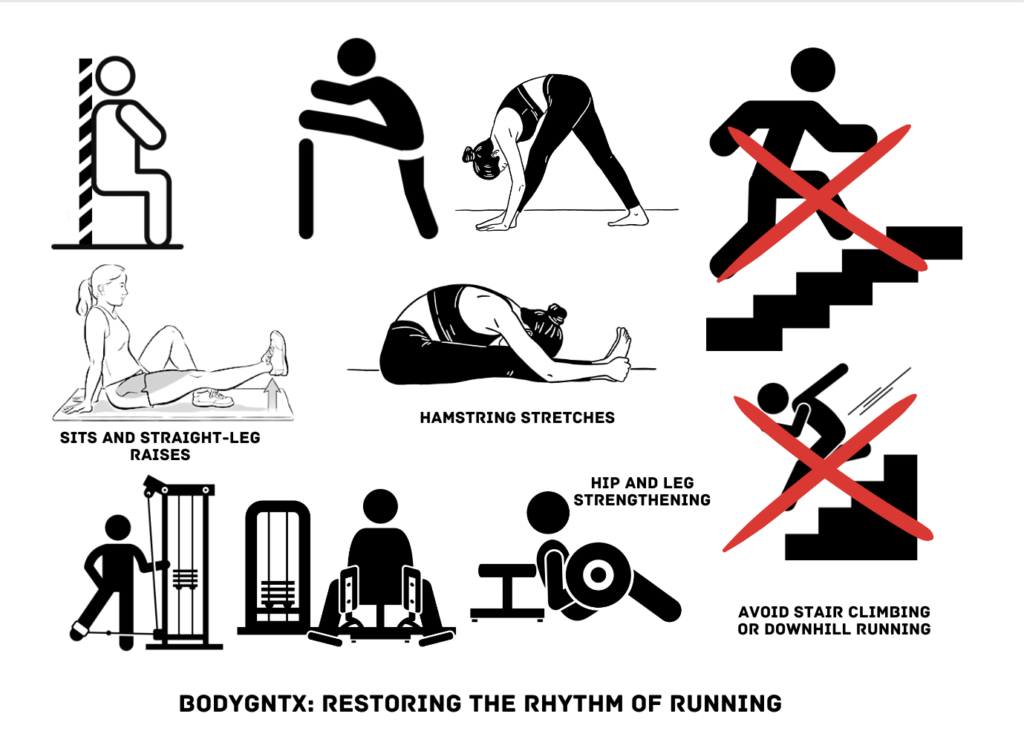
The Sole’s Lament: Plantar Fasciitis
Inflammation of the connective tissue along the bottom of the foot can cause this persistent pain. Triggers include:
- Flat or high-arched feet putting extra strain on the plantar fascia.
- Overtraining or sudden increases in mileage.
- Worn-out shoes lacking adequate cushioning and support.
Relieving the Strain:
- Ice and rest help reduce inflammation and promote recovery.
- Gentle stretches for the plantar fascia and calves improve range of motion and decrease discomfort.
- Orthotics or arch support inserts can help distribute pressure evenly across the foot.
- Night splints stretch the plantar fascia and reduce morning pain.
- Gradually increase mileage and intensity to avoid re-aggravation.
- Choose shoes with good shock absorption to protect the plantar fascia.

Remember, seeking professional medical advice is crucial for accurate diagnosis and personalized treatment plans for specific running injuries.
Beyond the Music: Resources and Inspiration
This guide is just the beginning of your journey into the world of running biomechanics. To further your understanding and equip your athletes with the best possible tools, consider exploring these resources:
- Books: “Anatomy for Runners” by Jay Dicharry, “Biomechanics of Running” by Peter R. Cavanagh
- Websites: Runners World (runnersworld.com), American Council on Exercise (acefitness.org)
- Courses: Online biomechanics courses for coaches and trainers
Don’t forget to celebrate your athletes’ achievements and inspire them to continuously refine their movement. Remember, every runner has the potential to reach their full potential with dedication, proper training, and a deep understanding of the music within their bodies. Let this guide be your compass, helping your athletes navigate the sometimes-challenging terrain of running and reach the finish line with grace and power.
Below are some useful links for understanding it better:
General Running Biomechanics:
- American Council on Exercise (ACE): Running Biomechanics: https://tbmm-acefitness.inspire360.com/
- Runners World: Running Technique: https://www.runnersworld.com/training/a20864133/4-ways-to-master-your-running-form/
- International Association of Athletics Federations (IAAF): Biomechanics Research: https://worldathletics.org/about-iaaf/documents/research-centre
- Human Anatomy and Physiology of Running Specialization on Coursera: https://www.coursera.org/learn/anatomy403-1x
- Biomechanics of Sport and Exercise on edX: https://www.edx.org/learn/sports-business
Footstrike Types:
- “Foot Strike Patterns and Injuries in Distance Running” by Stacoff et al. (2007): https://pubmed.ncbi.nlm.nih.gov/35333026/
- “Midfoot strike running reduces tibial shock compared to rearfoot strike running” by Daoud et al. (2012): https://pubmed.ncbi.nlm.nih.gov/24424959/
- “The Effect of Forefoot Strike Technique on Ground Reaction Forces in Distance Running” by Lieberman et al. (2005): https://www.ncbi.nlm.nih.gov/pmc/articles/PMC7734358/
Muscle Imbalances:
- “The relationship between hip strength and running injuries in long-distance runners” by Hoshikawa et al. (2016): https://pubmed.ncbi.nlm.nih.gov/27693442/
- “Prevalence and predictors of hamstring tightness in distance runners” by Messier et al. (2009): https://www.ncbi.nlm.nih.gov/pmc/articles/PMC3418114/
- “Hip Flexor Tightness and Its Relation to Runner’s Knee: A Systematic Review” by Barton et al. (2020): https://pubmed.ncbi.nlm.nih.gov/33671271/
Common Running Injuries:
- “Epidemiology of Running Injuries” by Junge et al. (2013): https://pubmed.ncbi.nlm.nih.gov/1439399/
- “Treatment of Shin Splints” by American Academy of Orthopaedic Surgeons: http://teamdoctorsblog.com/2012/12/21/shint-splints-self-help-tips-treatment-and-prevention-from-team-doctors/
- “Runner’s Knee: Clinical diagnosis and treatment” by Khan et al. (2009): https://www.ncbi.nlm.nih.gov/books/NBK561507/
- “Plantar Fasciitis” by Mayo Clinic: https://sportsmedicine.mayoclinic.org/condition/plantar-fasciitis/
Training and Drills:
- “High-intensity interval training improves maximal aerobic capacity in female distance runners” by Helgerud et al. (2001): https://www.superrunning.net/blog/research-article-maximal-strength-training-improves-aerobic-endurance-performance
- “Plyometric training improves performance and prevents injuries in athletes” by Cronin et al. (2008): https://www.ncbi.nlm.nih.gov/pmc/articles/PMC5260592/
- “Strength training for female runners: A systematic review” by Beets et al. (2009): https://pubmed.ncbi.nlm.nih.gov/34360184/
- “Running Drills for Beginners” by Verywell Fit: https://www.verywellfit.com/running-overview-4581850
- “10 Running Drills to Improve Your Stride” by Runner’s World: https://runningmagazine.ca/sections/training/running-drills-to-improve-your-stride/
Below are the latest website links for Running Biomechanics:
Websites:
- Physio-pedia: https://www.physio-pedia.com/Gait
- ScienceDirect:
- “The biomechanics of running” by T.F. Novacheck: https://pubmed.ncbi.nlm.nih.gov/10200378/
- National Institutes of Health (.gov):
- “An Evidence-Based Videotaped Running Biomechanics Analysis”: https://pubmed.ncbi.nlm.nih.gov/26616185/
- SlideShare:
- “Running biomechanics | PPT”: https://www.slideshare.net/NeetiChristian1/biomechanics-of-running
- Runner’s Connect:
- “Introduction to Running Biomechanics”: https://www.physio-pedia.com/Running_Biomechanics?fbclid=IwAR3SK876-iIk-ReToSFUz59GjrpnNhTtFQByV19RE_xKKkUOmpyUo5CECUk
- XSENSOR:
- “What You Need to Know About Running Biomechanics”: https://www.xsens.com/hubfs/Downloads/Whitepapers/Xsens%20-%20MVN%20Gait%20report%20white%20paper.pdf
- ResearchGate:
- “Biomechanics of running: An overview on gait cycle”: https://www.researchgate.net/publication/353030126_Biomechanics_of_running_An_overview_on_gait_cycle
Videos:
- YouTube:
- “Biomechanics of Movement | Lecture 3.4: The Running Gait” by Professor Scott Delp: https://m.youtube.com/watch?v=Iz6t9ZnviiQ
- “Biomechanics of Running: The Science of Movement” by C2ST TV: https://www.youtube.com/watch?v=5L1-hEYwhA4
- “Biomechanics of running” by Bupa Health UK: https://www.youtube.com/watch?v=hhqBDyadwe4
Books:
- Running: Biomechanics and Exercise Physiology in Practice: https://www.amazon.com/Running-Biomechanics-Exercise-Physiology-Practice/dp/0443074410
Additional Resources:
- Frontiers in Bioengineering and Biotechnology: https://www.frontiersin.org/journals/bioengineering-and-biotechnology
- Amazon.in:
- “Running Biomechanics Simplified”: https://www.physio-pedia.com/Running_Biomechanics
- Sheffied Sports Medicine:
- “Running Technique Assessment | Biomechanics & Gait Analysis”: https://www.sheffieldsportsmedicine.com/biomechanics
- Triathlon Scotland:
- “Running Biomechanics”: https://www.triathlonscotland.org/wp-content/uploads/Running-Biomechanics.pdf
#running, #runners, #runchat, #runlife, #runningmotivation, #instarunners, #runningcommunity, #runnersofinstagram, #runhappy, #iloverunning, #runninggirl, #runningman, #trailrunning, #marathon, #run, #fitness, #workout, #training, #instarun, #garmin, #strava, #runforfun, #runnersworld, #biomechanics, #runningbiomechanics, #formmatters, #technique, #runningtechnique, #runningform, #runningtips, #injuryprevention, #runsmarter, #movement, #athlete, #trainsmarter, #sportsscience, #sportsperformance, #strengthandconditioning, #runningcoach, #coach, #coaching, #coachlife, #athletes, #trainhard, #trainsmart, #personaltrainer, #fitnesscoach, #strengthcoach, #performance, #sportscoaching, #reachyourpotential, #peakperformance, #personalbest, #fasterstrongerbetter, #athletedevelopment, #trainlikeapro, #breakthrough, #runninggoals, #nevergiveup, #believeinyourself
